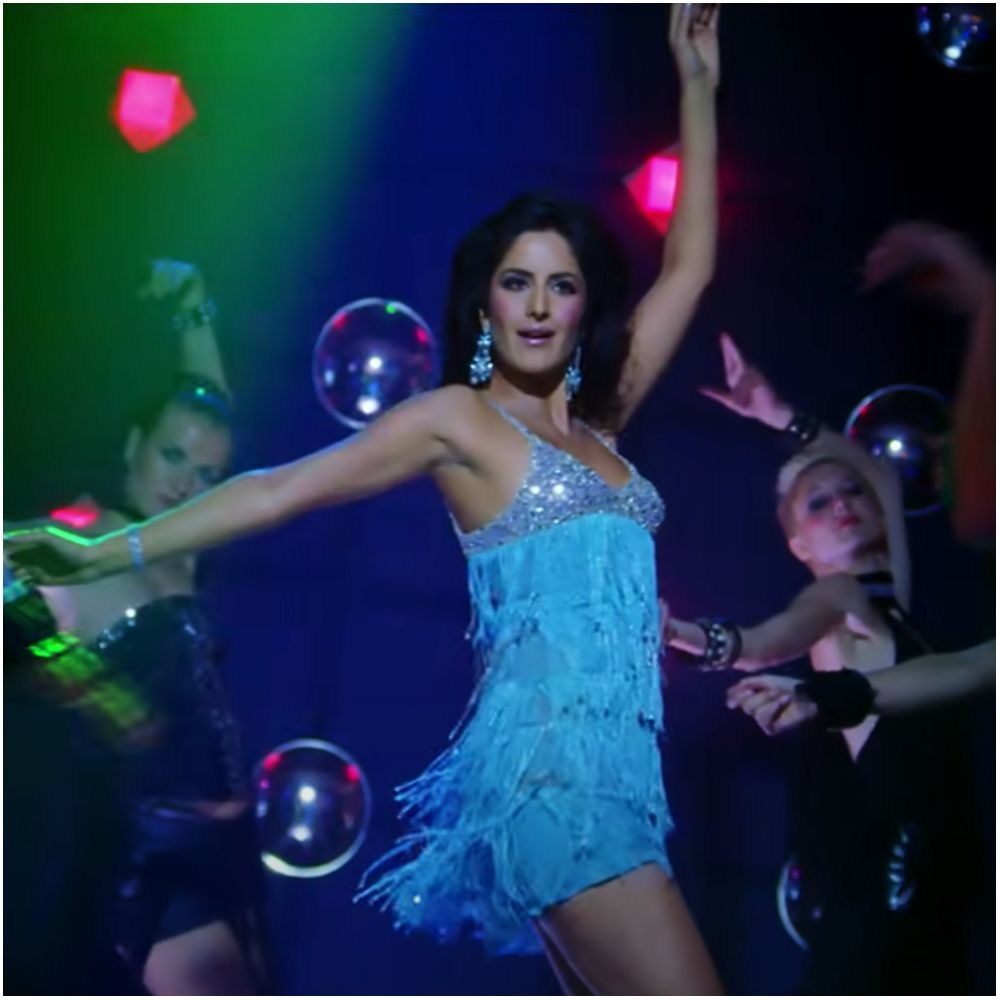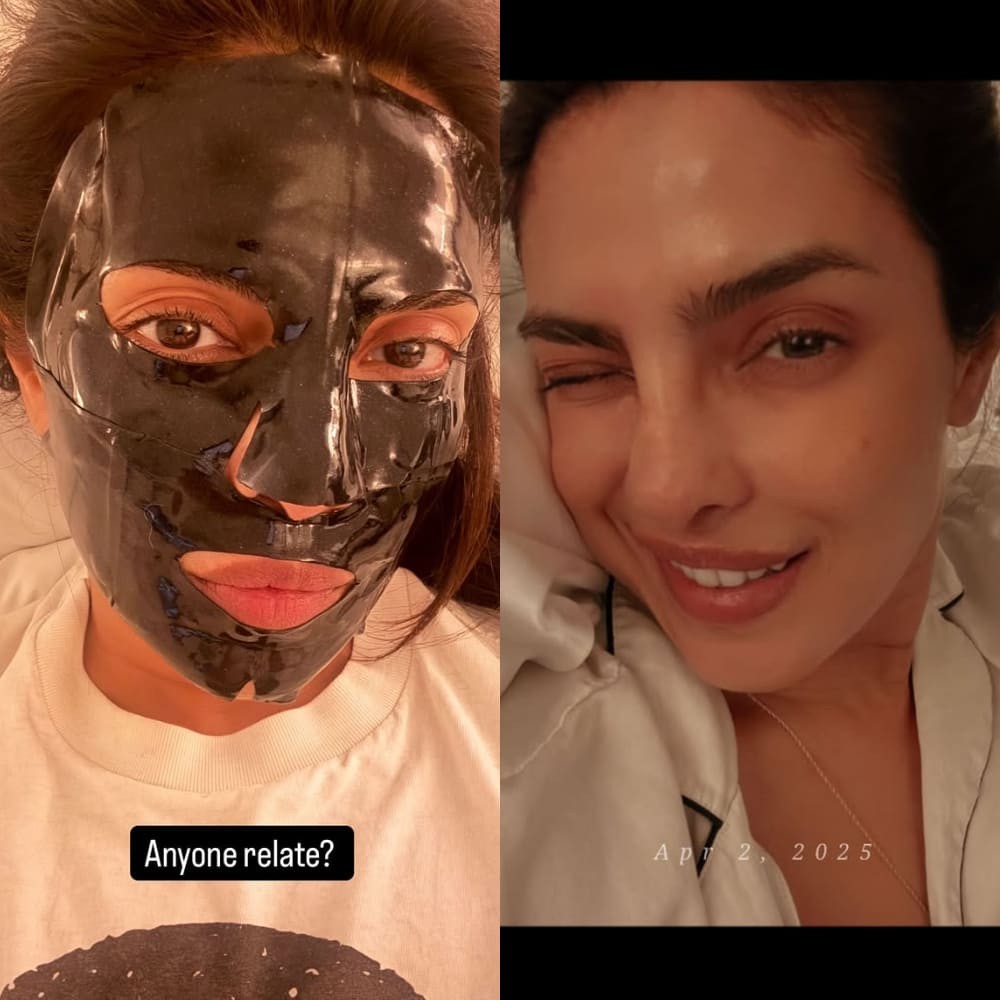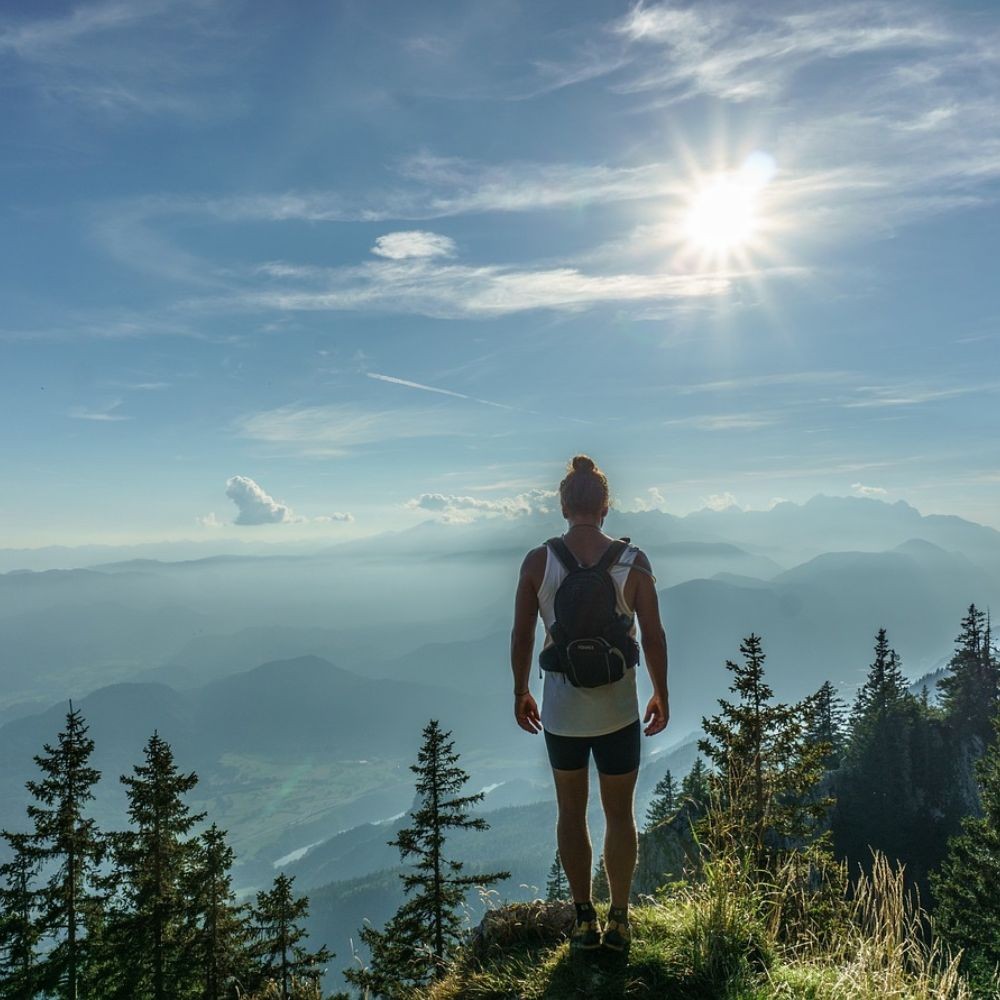15 Hip Opening Yoga Poses for Better Mobility And Balance
Hip opening yoga poses enhance flexibility, achieve balance, and release tension. Unlock a world of comfort and agility with these transformative stretches.
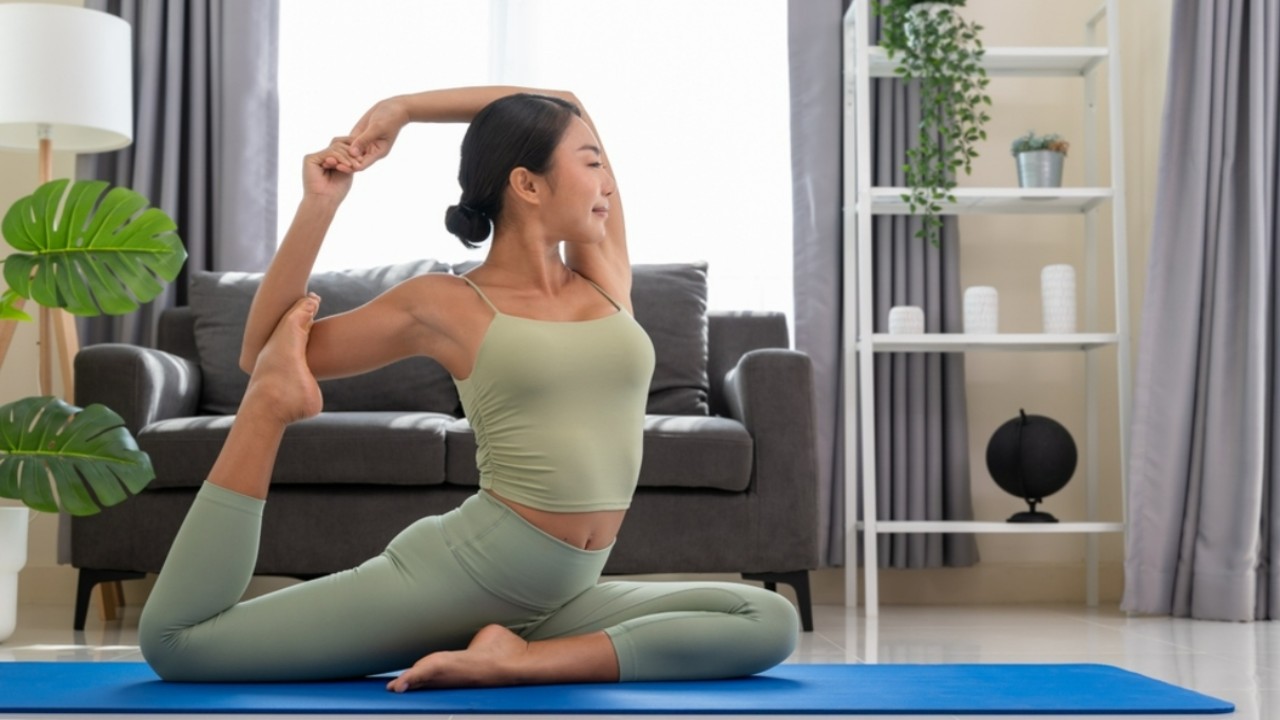
Yoga has always been a ray of hope for those seeking physical wellness and inner tranquility. Among the myriad of poses and sequences, the magic of hip opening yoga poses shines brightly. These poses are more than mere stretches; they are an invitation to unlock the vast potential of one of our body's most pivotal joints, the hips. Delving into postures such as child pose or downward facing dog frees the femur's range and caresses the muscles encircling the hip joint, granting them renewed life.
Our contributor Bayu Prihandito, Life Coach, and RYT 200 Yoga Teacher, says, “Child Pose gently stretches the hips, thighs, and ankles, helping to release any built-up tension in these areas. This posture promotes deep relaxation and circulation, which is essential for relieving pain from joints.”
Modern lifestyles, replete with hours of sitting and limited movement, have left many grappling with the discomfort of tight hips (1). This tightness isn't merely physical; it reverberates throughout our body, disturbing our balance, hampering mobility, and often leading to a domino effect of bodily aches (1). But there's hope on the horizon, emanating from the ancient practice of yoga.
The subtle charm of hip opening exercises extends beyond the physical realm. The intricate web of muscles, especially the hip flexors, plays a crucial role in actions as basic as walking or running. By dedicating time to hip-focused asanas, you pave the way for greater flexibility and usher in a sense of holistic wellness.
What Are Hip Opening Yoga Poses?
A hip opening pose in yoga refers to any asana or posture designed to stretch and release the muscles surrounding the hip joint. These poses target various muscle groups, such as the buttocks, tight hamstrings, inner thighs, groin, and abdomen. Given the sedentary lifestyles many people lead today, especially those who work desk jobs, these muscles tend to become tight and constricted (1). Such tightness can lead to discomfort, including lower back pain. Thus, exercises to open hips become essential in alleviating these muscle tensions and promoting flexibility and ease in the hip area.
Why Are Hip Opening Yoga Poses Important?
Hip opener poses are vital for physical and mental well-being. Tight hips can strain the back, leading to lumbar spine issues and pain. Expanding hip mobility through yoga enhances circulation and reduces stiffness (2).
Our contributor Bayu Prihandito, says, “Hip opening exercises like Pigeon Pose or Frog Pose allow gradual increase of flexibility and motion in the hip joints. With regular practice it can also reduce tightness and alleviate discomfort in the hips.”
Modern lifestyles often tighten hip muscles, whether from prolonged sitting or repetitive activities. Historically, yoga emphasized meditation, with poses giving way to comfortable stretches and cross-legged sitting. Today, our chair-bound lives limit natural hip movement. Incorporating hip opening poses is essential to maintain flexibility and prevent discomfort.
15 Hip Opening Yoga Poses for Improved Mobility
Hips often hold a lot of tension and stress. Tight hips can lead to problems in the lower back and knees, and they can even impact our posture. Fortunately, yoga offers a range of poses designed to open, stretch, and strengthen the hip area. Here, we will explore five potent hip-opening asanas, along with their detailed instructions.
1. One-legged Forward Bend (Janu Sirsasana)
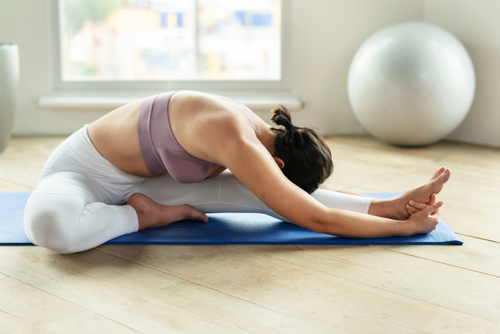
The One-legged Forward Bend relieves back pain, enhances blood circulation and hip mobility, offers immense stress relief, and rejuvenates the body.
- Sit down with your legs straight out and keep your back straight.
- Bend your left knee, putting your left foot by your right leg. Your left knee should touch the floor.
- Breathe in, lift your arms up high, and slightly turn to the right.
- Breathe out and lean forward, chin aiming for your toes.
- If possible, grab your big toes. Push your elbows down and pull on your toes.
- Stay in that pose and breathe.
- Breathe in, sit up straight, and breathe out, putting your arms down.
- Do the same steps for the other side.
2. Child’s Pose (Balasana)
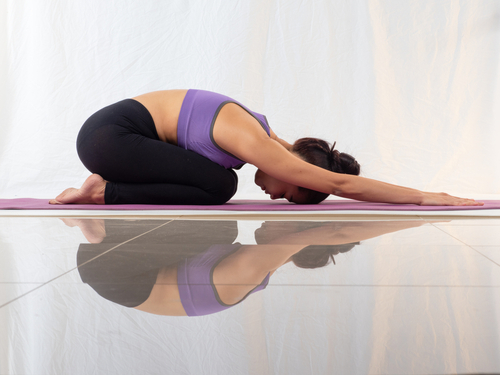
Balasana is a restorative pose that provides a gentle hip stretch and relieves tension.
- Begin by kneeling.
- Bring your toes together while opening the knees wide.
- Extend your arms forward, slowly resting your forehead on the mat.
- Keep the pose active by drawing the thighs inward and pulling the chest forward.
Note: You can place a block or pillow beneath your seat for added support. For a gentler stretch, keep the knees closer together.
3. Low Lunge
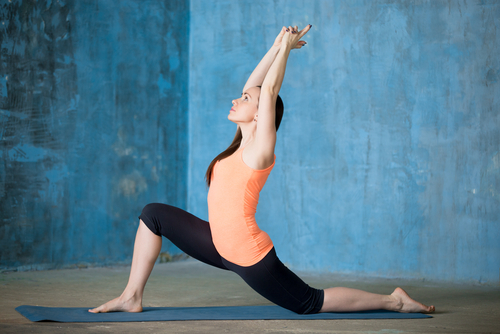
Low lunge stretches the hip flexors, helps in leg stretch, and strengthens muscles.
- Start in the Downward Dog position.
- Breathe in and put weight on your left foot.
- Breathe out and move your right foot forward near your right hand.
- Move your body forward, making sure your right knee is over your ankle.
- Put your left knee down on the ground.
- Breathe in and put your hands on your right knee.
- Press both feet into the ground, stand tall, and look up.
- Raise your arms, hands facing each other, and keep your shoulders relaxed.
- Tighten your butt and stomach muscles to stay balanced.
- Do the same steps for your left side.
Note: You can use blocks under the hands for added support.
4. Twisted Runner’s Lunge (Quad Stretch)
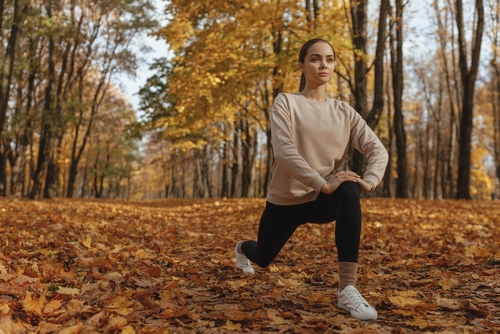
Quad stretch enhances hip opening by targeting the quads.
- Assume the runner's lunge position. A runner’s lunge is a stance with one leg bent forward and flat on the ground while the other is extended behind.
- Bend the back knee.
- With the opposite hand, grab the back foot, drawing the hips forward and the heel towards the glute.
Note: Use a strap or towel if the foot is unreachable. For added lift, use a block under the front hand.
5. Side Lunge (Skandasana)
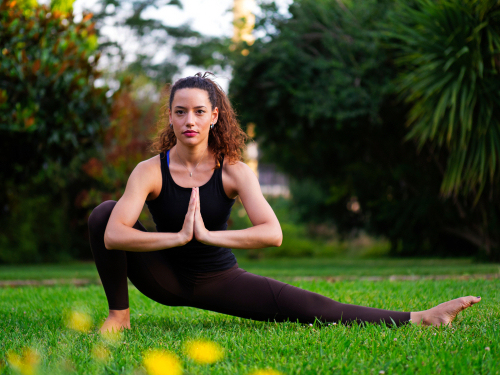
Side lunges can help stretch the inner thighs and improve hip flexibility.
- Start by standing and spread your legs wide apart.
- Bend your left knee while keeping the right one straight.
- Point your right toe upwards.
- Press firmly into your right heel and left foot for balance.
- Keep your back straight.
- Choose a hand position:
- Together at your chest
- Spread out like in the Triangle pose
- Raised above your head.
- Or try wrapping them around the bent leg for more challenge.
- Do the same thing for the right leg.
6. Frog Pose
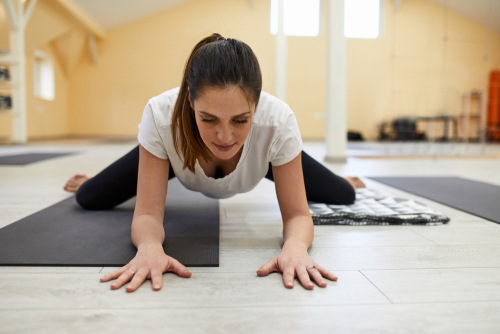
Frog pose is a profound stretch for the inner thighs and groins.
- Starting on the tabletop, widen your knees.
- Flex your feet, aligning your ankles with your knees.
- Drop onto your forearms or extend your arms forward.
Note: You can place a block beneath the pelvis for support.
7. Cow Face Pose (Gomukhasana)
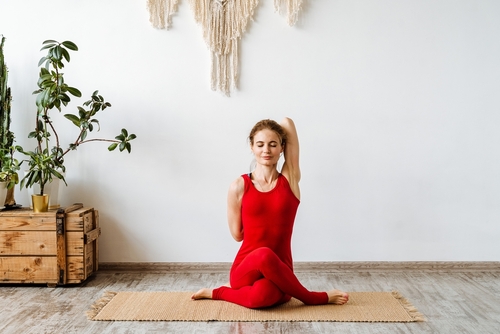
Cow face pose works on multiple body parts, promoting overall flexibility.
- Sit on the ground with your legs bent.
- Bend one leg in a crossed position, and step the other leg over the bent knee.
- Stack your knees and pull the heels towards the hips.
- Take a deep breath. Stretch your right arm to the side, turn your hand so the palm faces behind, and thumb points down.
- Breathe out, bend your right elbow, and move your arm behind your back. Your hand should face out, with your arm close to your side. Your elbow points to your lower back and your fingers aim near your neck's base.
- Breathe in and lift your left arm sideways and then upwards, palm facing the center.
- Now, bend your left elbow, letting your hand move down your back. Keep your elbow near your face, pointing up, while your hand moves down your spine.
- Try to make your hands meet. If they do, hold them together.
- To get out of this position, breathe out, stretch your arms to the sides, and sit straight.
- Do the same steps for the other side.
8. Bridge Pose (Setu Bandha Sarvangasana)
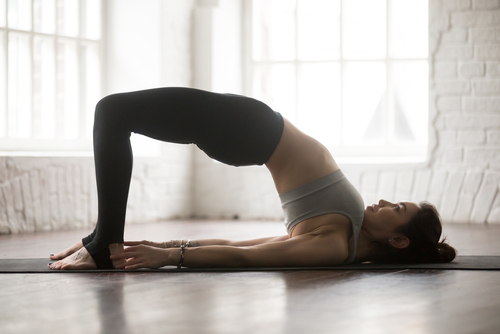
The Bridge pose can strengthen the back muscles and stretch the chest.
- Lie flat on the back with knees bent.
- Lift the hips, feeling the stretch along the hip flexors.
- Practice a supported bridge pose with yoga blocks for relaxation.
9. Happy Baby (Ananda Balasana)
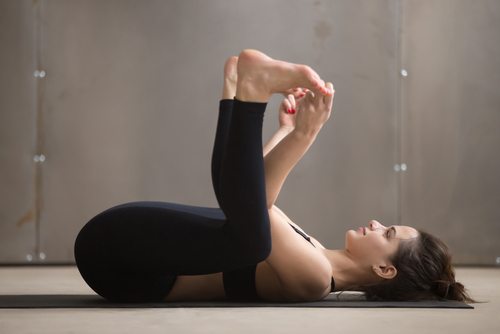
The Happy Baby pose works on strengthening the inner thighs, hips, and hamstrings.
- Lie flat and bring the knees to the chest.
- Hold the soles of the feet and press them upwards.
- For a little modification, hold the back of the knees or the big toes instead.
10. One-legged Pigeon Pose (Kapotasana)
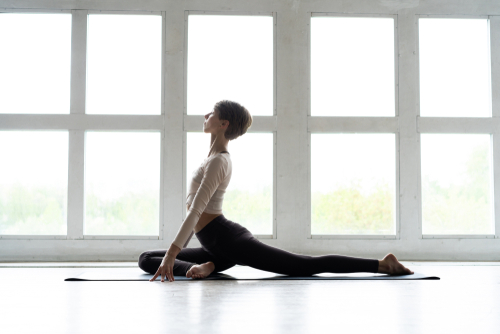
Kapotasana is a wonderful hip opener. It relaxes the lower back and hip region muscles, providing a soothing massage-like effect.
- Start in Downward Facing Dog (The Downward-facing dog pose or Adho Mukha Svanasana shapes your body into an inverted "V". Press your hands and feet down while lifting your hips for strength and flexibility.).
- Bring your right leg forward, placing the knee between your palms.
- Extend your left leg straight behind you.
- Position your palms beside your thighs. Arch your back and look up, or if challenging, look straight ahead.
- Ensure the sacroiliac joint (the joint that links the pelvis and lower spine) remains stress-free. Focus on arching the upper body, keeping the lower back stable.
- Depending on your flexibility, either point your right foot outwards or towards your body.
- Maintain this pose, taking several deep breaths and noticing the stretches in the lower back, hips, and thighs.
- Repeat with the left leg.
11. King Pigeon (Eka Pada Rajakapotasana)
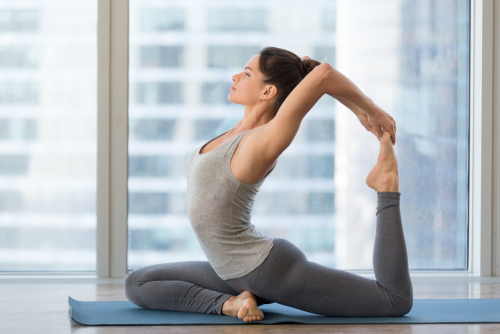
King pigeon is a deep stretch for those with advanced flexibility. This is a continuation of the one-legged pigeon pose.
- From the one-legged pigeon pose, bend the back knee.
- Use the hand on the same side to grasp the back foot.
Note: In case gripping the foot is challenging, use a strap or towel.
12. Lizard Pose (Uttana Pristhasana)
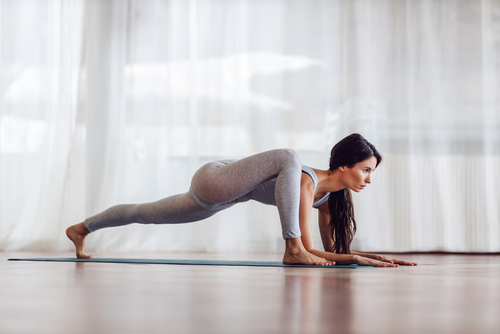
Known as a top hip-opener, the lizard pose offers a deep stretch to the hip region. It strengthens and stretches muscles, releasing tightness and tension.
- Begin in a low lunge, placing your right foot between your hands, ensuring the knee is directly over the ankle.
- Position your right hand inside the right foot so both hands are near each other.
- For a deeper stretch, lower onto your forearms. You can opt to elevate your left knee or rest it on the floor. Use a blanket or cushion beneath the knee for added comfort if necessary.
- If desired, gently rock your body back and forth.
13. Bound Angle Pose (Baddha Konasana)
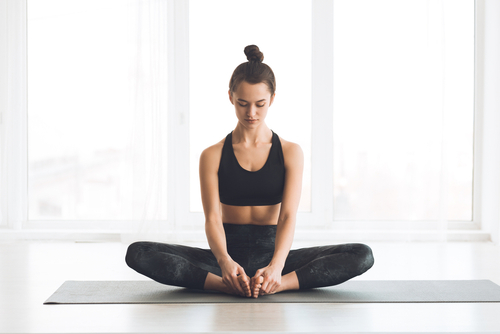
Ideal for beginners, this pose helps release tightness around the hips and lower back.
- Sit with a straight spine, legs extended wide apart.
- Bend your legs, bringing the feet towards the groin. The soles should touch each other.
- Hold onto your feet or toes. If needed, place your hands on the mat for support, ensuring your back remains straight.
- Try to draw your feet closer to the groin.
- Gently push your right and left thigh and knees towards the mat without straining.
- Engage the core and focus on the stretch felt in the groin, inner thighs, and back.
- Remain in this pose for several breaths.
- To release, exhale, and let go of your feet.
14. Garland Pose (Malasana)
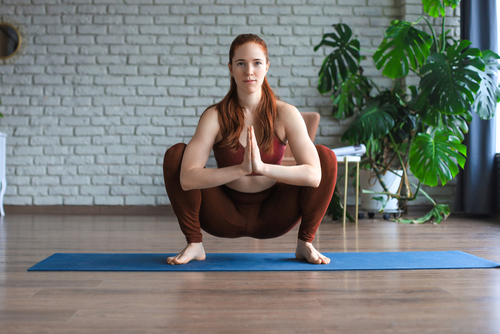
This yogic squat enhances blood circulation in the pelvis and abdomen, strengthens the pelvic floor muscles, and opens up the hip region resulting in hip flexibility.
- Stand with feet shoulder-width apart, toes pointing outward.
- Slowly squat down.
- Join your palms in Namaskar mudra between your thighs, using elbows to push them further apart.
- Hold the pose for 5-10 breaths.
- For a deeper stretch, try variations like standing on toes or walking in a squat position on the mat.
15. Standing Wide-Legged Forward Bend (Prasarita Padottanasana)
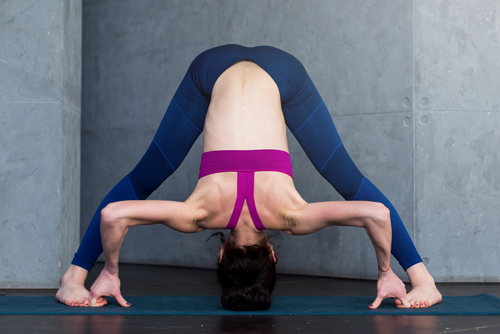
This asana stretches the back of the legs, thigh bones, hips, and inner groin. It enhances hip mobility and offers isolated hamstring stretch, strengthening the legs and back muscles.
- Begin standing straight in Tadasana (Tadasana is a simple yoga stance where you stand tall and straight with your feet flat on the ground.).
- Step your feet 3-4 feet apart, toes facing forward.
- Holding your waist, inhale, arch your back slightly, and lengthen the spine. Exhale and hinge forward from the hips.
- Keep your feet firmly planted, aiming to keep the spine elongated.
- Try to touch the top of your head to the floor, placing palms or forearms next to your head on the mat.
- Maintain this position, breathing deeply.
- To exit, inhale, lifting the head first. With hands on your waist, rise through the spine and trunk.
- Exhale, release your arms, and relax in Tadasana.
Practicing hip-opening yoga poses often can improve flexibility, strength, and overall health. Always pay attention to how your body feels, be patient, and seek advice from a yoga expert if you are unsure or worried.
Benefits of Hip Opening Yoga Poses
The practice of yoga offers an array of physical, emotional, and mental benefits. Among these, the best hip opening stretches are especially impactful, offering numerous advantages that go beyond mere flexibility. These poses are essential for injury prevention, ensuring the health of our hips and knees, and promoting overall body stability (3). Let's take a look at how these can be helpful for a modern-day lifestyle.
- May Prevent Injury
These poses alleviate tension in the back and hip areas. By stretching and strengthening hip muscles, they act like therapeutic massages. These hip opening poses reduce hip pain, correct spinal misalignments, and sports injuries, and mitigate long-term damage, especially when targeting all hip facets (3).
- May Protect Your Hips and Knees
Properly executed hip-opening poses safeguard our hips and knees. While knees have limited movement, hips bear the most rotational stress. Focusing on hip-specific yoga poses ensures both joints remain healthy.
- May Improve Entire Body Balance and Stability
Open hips mean greater movement freedom and strength. The connection between the hips and the pelvic region involves many muscles linked by connective tissues (4). Yoga poses targeting this area introduce the range of motion needed for flexibility, improving overall body balance, and reducing pain risks (4).
Hip opening exercises, when integrated into one's regular practice, offer various benefits (like maintaining a proper body weight) that resonate through the body. They serve as a protective shield against injuries, ensure the well-being of our hips and knees, and lay the foundation for a balanced and stable physique (5).
Tips for Safe And Effective Hip-Opening Yoga
The practice of yoga offers a huge number of physical and mental benefits. Among the many asanas or postures, hip-opening poses are especially revered for their ability to alleviate tension, improve flexibility, and promote emotional release. However, it's essential to approach these poses with a sense of caution and awareness.
Below are some key guidelines to ensure your hip-opening yoga journey is safe and effective.
- Prioritize Comfort Over Depth
It's easy to get caught up in achieving a deeper stretch or reaching an advanced posture. However, the essence of yoga lies in listening to one's body. Instead of pushing yourself to the limit, find a balance where you can feel the stretch without pain. The depth of the pose should always be secondary to the comfort and safety of your body.
- Maintain Proper Alignment
Alignment is a fundamental aspect of any yoga practice. In hip-opening poses, paying attention to your alignment can prevent unwanted strain and potential injury (4). One crucial recommendation for students is to ensure that the knees and toes point in the same direction. This alignment helps in evenly distributing the stretch and avoiding undue pressure on the knee joints, thus preventing any torquing or twisting that could harm the joint.
- Warm Up Adequately
Before diving into deep hip-opening postures, it's essential to prepare the body with some warm-up exercises. Gentle stretches and movements lubricate the joints, warm up the muscles, and increase circulation, making the body more receptive to the subsequent deeper stretches.
- Stay Mindful and Present
Yoga is as much about the mind as it is about the body. Being mindful means being wholly present in the moment and paying attention to every sensation. When practicing hip-opening poses, tune into the subtle signals your body sends. If you notice any discomfort, adjust your posture or come out of the pose.
- Consistency Over Intensity
Instead of practicing hip-openers occasionally, aim for consistency. Regular, moderate practice can yield better results in terms of flexibility and strength than sporadic, intense sessions. It's the consistent practice that allows the body to open up gradually and safely.
- Use Props When Needed
Yoga props like blocks, straps, and bolsters are not just for beginners. These tools can aid in maintaining proper alignment, deepening the stretch without strain, and providing support in certain poses. For a posture that feels too intense or you can't maintain proper alignment, incorporate a prop to make the pose more accessible.
Hip-opening poses in yoga are powerful tools for enhancing flexibility, releasing tension, and fostering overall well-being. However, like all tools, they should be used with care and understanding. By prioritizing comfort, ensuring proper alignment, and practicing mindfulness and consistency, you can reap the profound benefits of hip-opening yoga safely and effectively.
Conclusion
As we gently unfurl from the cocoon of daily life, hip opening yoga poses offer an invigorating blend of release and rejuvenation. It's not just about flexibility; it's a holistic approach to well-being. From the stretching solace of Janu Sirsasana to the grounding essence of Balasana and the dynamic challenge of Eka Pada Rajakapotasana, each asana has a story to tell, a gift of balance and strength to offer. By intertwining deep breathing with these poses, you don't just move; you flow, seamlessly connecting body, mind, and breath. So, the next time you roll out your yoga mat, consider weaving in these hip-openers. You'll not only nurture your hips but also create ripples of holistic wellness that cascade through every inch of your being. Happy practicing!
Contributor: Bayu Prihandito, Certified Psychology Consultant, Life Coach, and RYT 200 Yoga Teacher, Founder - Lifearchitekture





 JOIN OUR WHATSAPP CHANNEL
JOIN OUR WHATSAPP CHANNEL




